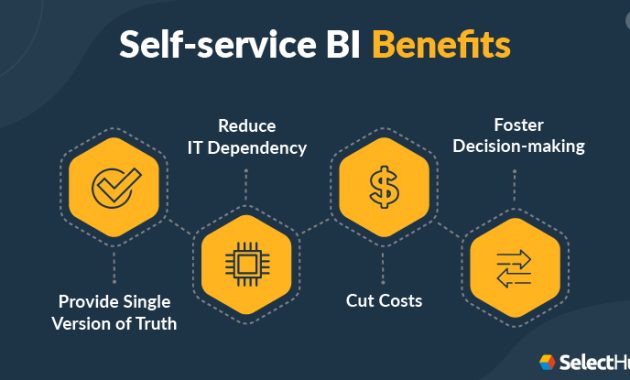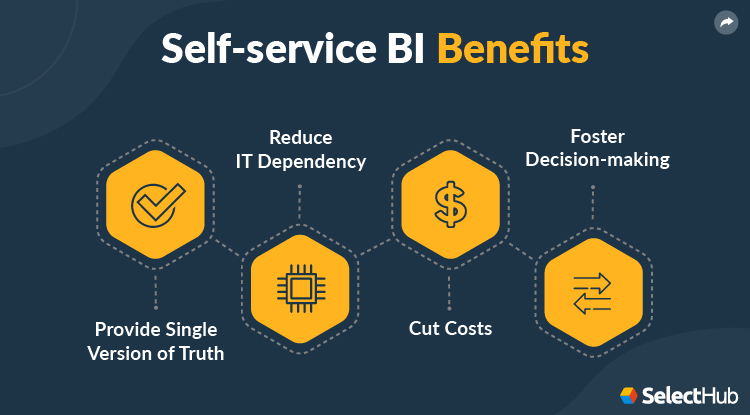
Unlocking Value: How Self-Service Business Intelligence Software is Revolutionizing Decision-Making
In today’s fast-paced business environment, data is king. But raw data alone is useless. The real power lies in the ability to analyze this data, extract meaningful insights, and make informed decisions. This is where self-service business intelligence software steps in, empowering users to explore data independently and uncover valuable trends. This article explores the transformative impact of this technology, focusing on how it delivers tangible value across various industries.
Self-service business intelligence software allows users to access, analyze, and visualize data without relying on IT or data science specialists. This democratization of data analysis puts the power of insights directly into the hands of those who need it most: business users. It enables faster decision-making, improved efficiency, and a deeper understanding of business performance. The value proposition is clear: better insights, faster results, and a more agile organization.
The Rise of Self-Service BI
The evolution of self-service business intelligence software has been dramatic. Initially, BI tools were complex and required specialized skills. However, user-friendly interfaces, drag-and-drop functionality, and pre-built dashboards have made these tools accessible to a wider audience. This shift has been driven by several factors:
- Increased Data Volume: Businesses are generating more data than ever before. Traditional BI methods struggle to keep up.
- Need for Speed: The pace of business requires rapid insights and agile decision-making.
- Demand for Empowerment: Business users want to control their data analysis and uncover their own insights.
These factors have fueled the demand for self-service business intelligence software, making it a critical component of modern business strategy. This software is no longer a luxury; it is a necessity for staying competitive.
Key Features and Capabilities
The best self-service business intelligence software solutions offer a range of powerful features. These capabilities empower users to extract maximum value from their data. Consider these essential components:
- Data Connectivity: Ability to connect to a wide variety of data sources, including databases, cloud services, and spreadsheets.
- Data Preparation: Tools for cleaning, transforming, and shaping data to ensure accuracy and consistency.
- Data Visualization: A range of charts, graphs, and dashboards to present data in an easily understandable format.
- Ad-hoc Analysis: The ability to explore data through interactive queries and visualizations.
- Collaboration: Features for sharing insights and collaborating with colleagues.
- Mobile Access: Access to dashboards and reports on mobile devices for on-the-go insights.
These features, combined, provide a comprehensive platform for data analysis and insight generation. The best software will integrate all of these seamlessly.
Demonstrating Value: Real-World Applications
The value of self-service business intelligence software is best demonstrated through real-world examples. Consider these use cases:
Sales and Marketing
Sales teams can use self-service business intelligence software to track sales performance, identify top-performing products, and analyze customer behavior. Marketing teams can use it to measure campaign effectiveness, optimize marketing spend, and understand customer engagement. This data empowers them to make smarter decisions.
Finance and Accounting
Finance departments can use BI tools to monitor financial performance, analyze profitability, and identify cost-saving opportunities. They can create dashboards to track key financial metrics in real-time. These insights improve financial planning.
Operations and Supply Chain
Operations teams can use self-service business intelligence software to optimize production processes, manage inventory levels, and improve supply chain efficiency. This leads to reduced costs and improved operational performance.
Human Resources
HR departments can use BI tools to analyze employee performance, track employee turnover, and identify areas for improvement in employee engagement. This data can inform strategies.
These are just a few examples. The versatility of self-service business intelligence software makes it applicable across almost every business function. The ability to extract actionable insights creates value.
Choosing the Right Self-Service BI Software
Selecting the right self-service business intelligence software is crucial for success. Consider these factors when evaluating different solutions:
- Ease of Use: The interface should be intuitive and easy to navigate, even for non-technical users.
- Data Connectivity: Ensure the software can connect to all your relevant data sources.
- Data Visualization Capabilities: The software should offer a wide range of visualization options.
- Scalability: The software should be able to handle your current and future data volumes.
- Security: Data security is paramount. Ensure the software offers robust security features.
- Cost: Consider the total cost of ownership, including licensing fees and implementation costs.
- Support and Training: Look for vendors that offer excellent support and training resources.
Thorough research and evaluation will help you choose the best solution for your needs. This will maximize the value you get from your investment.
Implementation and Best Practices
Successfully implementing self-service business intelligence software requires careful planning and execution. Follow these best practices:
- Define Your Goals: Clearly define your business objectives and the key performance indicators (KPIs) you want to track.
- Identify Data Sources: Determine which data sources are relevant to your goals.
- Clean and Prepare Your Data: Ensure your data is accurate, consistent, and properly formatted.
- Train Your Users: Provide adequate training to your users on how to use the software.
- Promote Data Literacy: Foster a data-driven culture within your organization.
- Monitor and Refine: Regularly review your dashboards and reports to ensure they are meeting your needs.
By following these best practices, you can maximize the value of your self-service business intelligence software investment. These steps will help you build a data-driven culture.
The Future of Self-Service BI
The future of self-service business intelligence software is bright. We can expect to see several trends in the coming years:
- Artificial Intelligence (AI) and Machine Learning (ML) Integration: AI and ML will be used to automate data analysis, generate insights, and predict future trends.
- Enhanced Data Governance: Data governance will become increasingly important to ensure data quality and security.
- Increased Mobile Accessibility: BI tools will become even more accessible on mobile devices.
- Greater Focus on Collaboration: Collaboration features will become more sophisticated.
These advancements will further enhance the value of self-service business intelligence software, making it an even more indispensable tool for businesses of all sizes. The potential is immense.
Conclusion
Self-service business intelligence software is transforming the way businesses operate. By empowering users to analyze their data and extract meaningful insights, this technology is driving faster decision-making, improved efficiency, and a deeper understanding of business performance. As businesses continue to generate vast amounts of data, the value of self-service business intelligence software will only increase. Embracing this technology is no longer optional. It is a strategic imperative for any organization that wants to thrive in today’s data-driven world. This software unlocks the true potential of data.
[See also: The Importance of Data Visualization, Data Governance Best Practices, How to Build a Data-Driven Culture]

